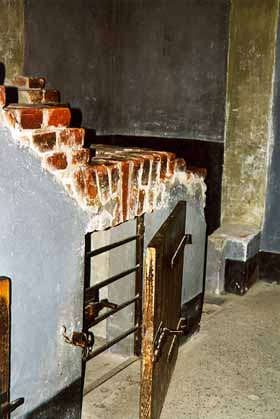Standing cells inside Block
11
 Entrance to standing
cell through tiny door
Entrance to standing
cell through tiny door
The 1998 photograph above shows the reconstructed
entrance to one of the 4 standing cells (Stehzellen) in prison
cell #22 in the basement of Block 11. These 4 cells were 31.5
inches square; there was no light coming in at all, and no heating
or cooling system.
Prisoners had to crawl into the cell
through a tiny door, as shown in the photo above. Metal bars
at the entrance allowed guards to open the door and look inside
the cell. There was no room to lie down or sit down in the cell;
prisoners had to stand up. The floors of these cells were covered
with excrement left by the occupants.
Prisoners who were being punished were
put into these cells at night, and in the morning taken out to
perform a full 10-hour day of work. This punishment was usually
given to prisoners who had tried to sabotage the work done in
the factories at Auschwitz.
The reconstructed door, which is shown
in the picture above, opens into Cell #2; there is another cell
to the right of the door, which you can see in the photo. To
the left in the picture above, you can see the edge of the door
into Cell #1 on the left, which gives you an idea of how small
these cells were. Imagine the problem of removing a dead body
from one of these cells!
After Arthur Liebehenschel replaced Rudolf
Hoess as the camp commandant on December 1, 1943, he ordered
the standing cells to be torn down. The standing cells have been
partially reconstructed, as the picture below shows.
 Standing cell with
wall cut away so visitors can see inside
Standing cell with
wall cut away so visitors can see inside
The photograph below shows a window with
bars on it, on the outside wall of Block 11, and just below the
window there is a small black metal box which looks something
like a mail box. There were tiny holes punched into the top of
this box to let a little bit of air into the 4 standing cells
which were behind this wall in the basement. During the winter
when snow covered these holes, the prisoners suffocated. Old
pictures taken when the camp was in operation show that there
were several of these boxes, but there is only one there now.
 Air vent for basement
prison cells
Air vent for basement
prison cells
Each Stehzelle (standing cell) was used
for third degree punishment, which consisted of 3 days in a dark
cell without room to lie down or sit. The standing cells were
about the size of a phone booth and had no windows.
A description of the standing cells in
Block 11 can be found in the book entitled "Das Bunkerbuch
des Blocks 11, im Nazi-Konzentrationslager Auschwitz," written
by Franciszek Brol, Gerard Wloch, and Jan Pilecki, Hefte von
Auschwitz (prisoners from Auschwitz), which was published in
1959. On page 120 of this book is a "Plan of the Bunker
of Block 11 redrawn after the original plan No. 1152 of March
16, 1942." On this plan, the four Stehzellen in Cell 22
are marked out and numbered 1-4.
This page was last updated on January
22, 2010
|